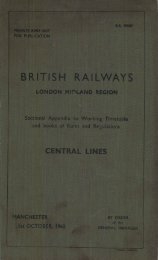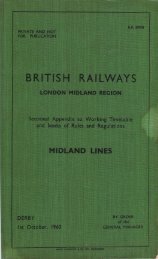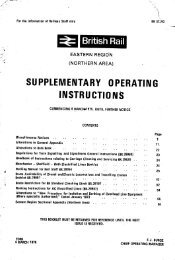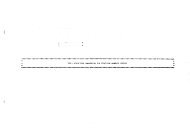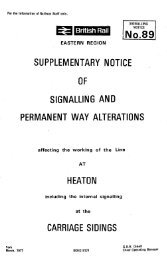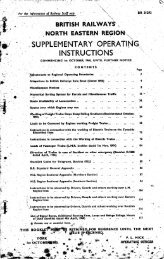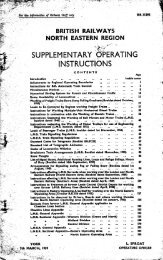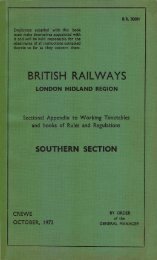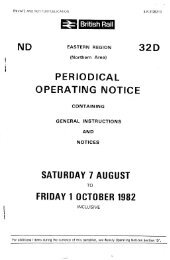general instructions. - Limit Of Shunt
general instructions. - Limit Of Shunt
general instructions. - Limit Of Shunt
You also want an ePaper? Increase the reach of your titles
YUMPU automatically turns print PDFs into web optimized ePapers that Google loves.
General Instructions,—(Continued). 1 8 5<br />
Fires occurring in connection with the conveyance of Acids, Matches,<br />
Charcoal, etc.—Continued.<br />
Charcoal.<br />
Some kinds of Charcoal are liable to ignite spontaneously, and damp<br />
charcoal is especially liable. It is best to unload the portion which is<br />
alight before putting out the fire with water. If this is not practicable,<br />
water may be used sparingly to extinguish the visible fire ; then, after<br />
removal of all the charcoal from the wagon, the wet should be separated<br />
from the dry. The portion remaining dry and undamaged should be forwarded<br />
with all speed to destination, and the wet portion should be stored<br />
in the open and held pending <strong>instructions</strong>. The special attention of the<br />
guard should be called to the load in either case.<br />
Cotton, Wool, etc.<br />
Bales of Cotton.<br />
before - extinguishing the fire under the water column or by buckets, as wetting<br />
the unburnt cotton increases the loss. Do not remove the bands, as loose<br />
cotton If oon nfire l y is difficult to deal with and the fire loss is greater. It is<br />
better, a after the blaze has been checked, to pluck out of the bales such<br />
of fthe ematerial w as is smouldering.<br />
b Cotton a in l bags e or Waste in bags.<br />
s -In<br />
all cases of cotton or wool fires special care is necessary to make sure<br />
that a Proceed the fire r is entirely a extinguished s as it tends to break oat again. Avoid<br />
as far as possible soiling the unburnt material with mud and dirt as it<br />
increases e w ithe t loss. h<br />
b c uo rt<br />
t o n<br />
Lime.<br />
n i i nn<br />
The g b<br />
lime , a<br />
near<br />
l<br />
the burning<br />
e s<br />
part<br />
.<br />
should be thrown out and fire extinguished,<br />
if possible, by smothering. If water has to be used, care must be taken<br />
not t to wet the lime remaining in the truck.<br />
r<br />
Matches.<br />
y<br />
If packed in a well-made case, although a few matches,may go off, they<br />
are t <strong>general</strong>ly smothered by their own smoke, which clears away without<br />
any o fire breaking out. In such cases, do not apply water. When, however,<br />
it is s clear ethat<br />
the contents of the case are really alight and water must be<br />
used, do not attempt to open the case.<br />
p a<br />
r a Spent Oxide from Gas Purifiers—Sulphur.<br />
Extinguish t e with water. The fires are <strong>general</strong>ly localised in the truck,<br />
and if the fire is discovered at the start the burning portion may be removed,<br />
but<br />
t<br />
a load after once being on fire is likely to kindle again, so keep under<br />
•special h observation. The fumes of the burning sulphur should be avoided.<br />
e<br />
(O. 7370).<br />
s<br />
e<br />
RESUMPTION OF DOUBLE LINE WORKING AFTER<br />
SINGLE LINE WORKING.<br />
General Rule 239.<br />
(a) When the line is clear, and before ordinary working is resumed, the<br />
-pilotman must accompany the driver of the first train in each direction,<br />
and withdraw the single line notices when he makes his first journey.




